Experimental Investigations on the Application of Natural Plant Fibers in Ultra-High-Performance Concrete
Abstract
:1. Introduction
2. State of Research
2.1. Ultra-High-Performance Concrete
2.2. Natural Plant Fibers
2.3. Natural Plant Fiber Reinforced Concrete
3. Experimental Investigations
3.1. Test Specimens
3.2. Test Execution
3.3. Test Results and Discussions
3.3.1. Compression Tests
3.3.2. Bending Tensile Tests
4. Life Cycle Assessment
4.1. Assessment
4.2. Discussion
5. Conclusions and Outlook
- Natural plant fibers are a sustainable alternative to conventional steel fibers in terms of their worldwide distribution and cultivation possibilities, rapid growth, easy harvesting and processing, and excellent mechanical properties;
- The modulus of elasticity of the UHPC is only slightly influenced by the addition of natural plant fibers—similar to the addition of steel fibers;
- Under axial compressive loading, the addition of natural plant fibers in the post-cracking area can prevent brittle failure of the UHPC by bridging the crack edges. However, the maximum compressive stresses and the associated strains of the test specimens reinforced with natural plant fibers are reduced by between 14 and 21% compared to the reference test specimens reinforced with steel fibers;
- Under bending tensile stress, a certain residual load-bearing capacity can be ensured for the test specimens reinforced with natural plant fibers due to the crack-bridging effect, but after cracking and the associated loss of stiffness—in contrast to the bending beams reinforced with steel fibers—no renewed increase in the test load can be recorded. In addition, the initial crack loads are significantly lower than those of the bending beams reinforced with steel fibers. The post-cracking bending tensile strength for the maximum value Fmax,m is only around 35 to 49% on average compared to micro steel fibers;
- The use of natural plant fibers instead of steel fibers leads to a significant reduction in global warming potential (GWP), as the GWP share can be reduced from around 22% to around 1%.
Author Contributions
Funding
Institutional Review Board Statement
Informed Consent Statement
Data Availability Statement
Conflicts of Interest
References
- Voo, Y.L.; Foster, S.J. Characteristics of ultra-high performance ‘ductile’ concrete and its impact on sustainable construction. IES J. Part A Civ. Struct. Eng. 2010, 3, 168–187. [Google Scholar] [CrossRef]
- Nematollahi, B.; Voo, Y.L. Application of Ultra High Performance Fiber Reinforced Concrete—The Malaysia Perspective. Int. J. Sust. Constr. Eng. Techn. 2012, 3, 26–44. [Google Scholar]
- Wilkening, M.; Schack, T.; Haist, M.; Oettel, V. UHPFRC-Fertigteilsegmente für einen nachhaltigen und ressourcenschonenden Betonbrückenbau. Beton-Und Stahlbetonbau 2023, 118, 788–802. [Google Scholar] [CrossRef]
- Wilkening, M.; Joachim, L.; Oettel, V. Investigations on the fatigue loading of thin-walled and resource-efficient UHPFRC segmental bridges. Eng. Struct. 2024, 306, 117858. [Google Scholar] [CrossRef]
- Brühwiler, E.; Friedl, H.; Rupp, C.; Escher, H. Bau einer Bahnbrücke aus bewehrtem UHFB. Beton-Und Stahlbetonbau 2019, 114, 337–345. [Google Scholar] [CrossRef]
- Delauzun, O.; Rogat, D.; Boutillon, L.; Linger, L.; Clergue, C. Construction of the PS34 UHPFRC Bridge. In Designing and Building with UHPFRC; John Wiley & Sons: London, UK, 2011; pp. 137–147. [Google Scholar] [CrossRef]
- Oettel, V.; Joachim, L.; Schmidt, B. Calculation approach of multi keyed dry joints for sustainable modular precast element constructions made of UHPFRC. Constr. Build. Mater. 2023, 370, 130687. [Google Scholar] [CrossRef]
- Joachim, L.; Wilkening, M.; Schmidt, B.; Oettel, V. Fatigue Loading of thin-walled, segmental UHPFRC Structures and its Influence on the Capacity of their Keyed Dry Joints. In Proceedings of the Symposium on Ultra-High Performance Concrete and High Performance Building Materials for Sustainable Construction, Kassel, Germany, 6–8 March 2024; pp. 185–188. [Google Scholar] [CrossRef]
- Kien, T.T. Comparison of energy consumption, CO2 emissions between normal concrete and UHPC in rural bridge application. J. Sci. Technol. Civ. Eng. (STCE)-NUCE 2023, 17, 168–179. [Google Scholar] [CrossRef]
- Oettel, V.; Empelmann, M. Große Stabdurchmesser und hohe Bewehrungsgrade—Teil 3, Druckglieder. Beton-Und Stahlbetonbau 2018, 113, 789–798. [Google Scholar] [CrossRef]
- Oettel, V.; Rieke, A.; Empelmann, M. Production and testing of thin-walled UHPFRC precast elements. BFT Int. 2014, 80, 64–74. [Google Scholar]
- Empelmann, M.; Oettel, V.; Cramer, J. Berechnung der Rissbreite von mit Stahlfasern und Betonstahl bewehrten Betonbauteilen. Beton-Und Stahlbetonbau 2020, 115, 136–145. [Google Scholar] [CrossRef]
- Oettel, V.; Lanwer, J.-P.; Empelmann, M. Auszugverhalten von Mikrostahlfasern aus UHPC unter monoton steigender und zyklischer Belastung. Bauingenieur 2021, 96, 1–10. [Google Scholar] [CrossRef]
- Heek, P.; Look, K.; Oettel, V.; Mark, P. Bemessung von Stahlfaserbeton und stahlfaserbewehrtem Stahlbeton. Beton-Und Stahlbetonbau 2021, 116, 2–12. [Google Scholar] [CrossRef]
- Mark, P.; Oettel, V.; Look, K.; Empelmann, M. Neuauflage DAfStb-Richtlinie Stahlfaserbeton. Beton-Und Stahlbetonbau 2021, 116, 19–25. [Google Scholar] [CrossRef]
- Lanwer, J.-P.; Oettel, V.; Empelmann, M.; Höper, S.; Kowalsky, U.; Dinkler, D. Bond behavior of micro steel fibers embedded in ultra-high performance concrete subjected to monotonic and cyclic loading. Struct. Concr. 2019, 20, 1243–1253. [Google Scholar] [CrossRef]
- Oettel, V.; Empelmann, M. Zugspannungs-Dehnungs-Beziehung für UHPFRC in Anlehnung an DAfStb-Richtlinie Stahlfaserbeton. Beton-Und Stahlbetonbau 2015, 110, 468–478. [Google Scholar] [CrossRef]
- Oettel, V.; Matz, H.; Empelmann, M. Bestimmung der zentrischen Nachrisszugfestigkeit von UHPFRC mithilfe gekerbter 3-Punkt-Biegezugversuche. Beton-Und Stahlbetonbau 2019, 114, 255–264. [Google Scholar] [CrossRef]
- Oettel, V. Torsionstragverhalten von Stahlfaserbewehrten Beton-, Stahlbeton- und Spannbetonbalken. Ph.D. Thesis, Technische Universität Braunschweig, Braunschweig, Germany, 2016. [Google Scholar] [CrossRef]
- Stürwald, S. Versuche zum Biegetragverhalten von UHPC mit Kombinierter Bewehrung; Forschungsbericht, Fachgebiet Massivbau; Universität Kassel: Hessen, Germany, 2011. [Google Scholar]
- Thiemicke, J. Zum Querkrafttragverhalten von UHPC-Balken mit Kombinierter Bewehrung aus Stahlfasern und Stabstahl. Ph.D. Thesis, Fachgebiet Massivbau, Universität Kassel, Hessen, Germany, 2014. [Google Scholar]
- Leutbecher, T.; Heck, L.; Metje, K.; Riedel, P. Predicting the moment resistance and localization strain of reinforced UHPFRC cross-sections subjected to bending. Eng. Struct. 2023, 293, 116607. [Google Scholar] [CrossRef]
- Metje, K.; Leutbecher, T. Verification of the shear resistance of UHPFRC beams—Design method for the German DAfStb Guideline and database evaluation. Eng. Struct. 2023, 277, 115439. [Google Scholar] [CrossRef]
- Oettel, V. Steel Fiber Reinforced RC Beams in Pure Torsion—Load-Bearing Behaviour and Modified Space Truss Model. Struct. Concr. 2023, 24, 1348–1363. [Google Scholar] [CrossRef]
- Hebel, D.E. Bamboo could turn the world. ECOS 2014, 1–3. [Google Scholar] [CrossRef]
- Hebel, D.E.; Heisel, F.; Javadian, A. Bambus statt Stahl. Betonexperimente-Tec21 2013, 35, 36–40. (In German) [Google Scholar]
- Hebel, D.E.; Heisel, F. Fiber Composite Reinforced Concrete—A Material Research, Tropical Zone Worldwide; Future Cities Laboratory: Singapore, 2013. [Google Scholar]
- Abd, S.M.; Mhaimeed, I.S.; Tayeh, B.A.; Najm, H.M.; Qaidi, S. Investigation of the use of textile carbon yarns as sustainable shear reinforcement in concrete beams. Case Stud. Constr. Mater. 2023, 18, e01765. [Google Scholar] [CrossRef]
- Chiluka, S. Evaluating the Effectiveness of Low-Cost Housing Methods in India. J. Civ. Constr. Eng. 2023, 9, 29–46. [Google Scholar]
- Das, S.; Warren, J.; West, D.; Schexnayder, S.M. Global Carbon Fiber Composites Supply Chain Competitiveness Analysis; Clean Energy Manufacturing Analysis Cente: Denver, CO, USA, 2016. [Google Scholar]
- Grand View Research. Glass Fiber Reinforced Concrete Market Size, Share & Trends Analysis Report By Process; Grand View Research: San Francisco, CA, USA, 2020. [Google Scholar]
- Ahmad, J.; Zhou, Z. Mechanical Properties of Natural as well as Synthetic Fiber Reinforced Concrete: A Review. Constr. Build. Mater. 2022, 333, 127353. [Google Scholar] [CrossRef]
- Navaratnam, S.; Selvaranjan, K.; Jayasooriya, D.; Rajeev, P.; Sanjayan, J. Applications of natural and synthetic fiber reinforced polymer in infrastructure: A suitability assessment. J. Build. Eng. 2023, 66, 105835. [Google Scholar] [CrossRef]
- Mei, X.; Liu, C.; Li, Z. Research progress on functional, structural and material design of plant-inspired green bionic buildings. Energy Build. 2024, 316, 114357. [Google Scholar] [CrossRef]
- Wagenführ, A. Naturfaserverbunde im Leichtbau. Lightweight Des. 2017, 10, 3. (In German) [Google Scholar] [CrossRef]
- Yan, L.; Chouw, N.; Huang, L.; Kasel, B. Effect of alkali treatment on microstructure and mechanical properties of coir fibres, coir fibre reinforced-polymer composites and reinforced-cementitious composites. Constr. Build. Mater. 2016, 112, 168–182. [Google Scholar] [CrossRef]
- Gonzalez-Lopez, L.; Claramunt, J.; Haurie, L.; Ventura, H.; Ardanuy, M. Study of the fire and thermal behaviour of façade panels made of natural fibre-reinforced cement-based composites. Constr. Build. Mat. 2021, 302, 124195. [Google Scholar] [CrossRef]
- Veerappan, P.; Mani, I.; John, A.; Madhavan, H. Experimental studies of coir and jute-fiber reinforced concrete with M-sand. Mater.-Rio De Jan. 2024, 29, e20240115. [Google Scholar] [CrossRef]
- Archila, H.; Kaminski, S.; Trujillo, D.; Escamilla, E.Z.; Harries, K.A. Bamboo reinforced concrete: A critical review. Mater. Struct. 2018, 51, 102. [Google Scholar] [CrossRef]
- Kesikidou, F.; Stefanidou, M. Natural fiber-reinforced mortars. J. Build. Eng. 2019, 25, 100786. [Google Scholar] [CrossRef]
- Momoh, E.O.; Osofero, A.I.; Menshykov, O. Bond Behaviour of Treated Natural Fibre in Concrete. Nano Hybrids Compos. 2022, 34, 37–44. [Google Scholar] [CrossRef]
- Bittner, C.M.; Oettel, V. Fiber Reinforced Concrete with Natural Plant Fibers—Investigations on the Application of Bamboo Fibers in Ultra-High Performance Concrete. Sustainability 2022, 14, 12011. [Google Scholar] [CrossRef]
- Zhang, D.; Tan, K.H.; Dasari, A.; Weng, Y. Effect of natural fibers on thermal spalling resistance of ultra-high performance concrete. Cem. Concr. Compos. 2020, 109, 103512. [Google Scholar] [CrossRef]
- Ridha, M. Combined effect of natural fibre and steel fibre on the thermal-mechanical properties of UHPC subjected to high temperature. Cem. Concr. Res. 2024, 180, 107510. [Google Scholar] [CrossRef]
- Oettel, V.; Empelmann, M. Druckstrebentragfähigkeit von vorgespannten UHPFRC-Hohlkästen unter Torsion und kombinierter Beanspruchung. Beton-Und Stahlbetonbau 2014, 109, 182–192. [Google Scholar] [CrossRef]
- Markowski, J.; Lohaus, L. Winding Reinforced UHPC Sandwich Structures for Lightweight Jackets for Offshore Megastructures. J. Phys. Conf. Ser. 2019, 1356, 012027. [Google Scholar] [CrossRef]
- German Committee for Structural Concrete. Sachstandsbericht Ultrahochfester Beton—Betontechnik und Bemessung; Beuth Publishing: Berlin, Germany, 2008. (In German) [Google Scholar]
- Fehling, E.; Leutbecher, T.; Walraven, J.; Schmidt, M.; Fröhlich, S. Ultra-High Performance Concrete UHPC. In Beton Kalender 2013: Lebensdauer und Instandsetzung-Brandschutz; Ernst & Sohn: Berlin, Germany, 2013; ISBN 978-3-433-03087-5. [Google Scholar]
- Yin, T.; Yu, R.; Liu, K.; Wang, Z.; Fan, D.; Wang, S.; Feng, Y.; Shui, Z. Precise mix-design of Ultra-High Performance Concrete (UHPC) based on physicochemical packing method: From the perspective of cement hydration. Constr. Build. Mater. 2022, 352, 128944. [Google Scholar] [CrossRef]
- Wiens, U. Erweiterte Untersuchungen zur Alkalitat von Betonen mit Hohen Puzzolangehalten; Fraunhofer IRB Publishing: Stuttgart, Germany, 1999. (In German) [Google Scholar]
- Gao, R.; Stroeven, P.; Hendriks, C.F. Mechanical Properties of Reactive Powder Concrete Beams; ACI Symposium Publication: Farmington Hills, MI, USA, 2005; Volume 228, pp. 1237–1252. [Google Scholar]
- Bertola, N.; Küpfer, C.; Kälin, E.; Brühwiler, E. Assessment of the Environmental Impacts of Bridge Designs Involving UHPFRC. Sustainability 2021, 13, 12399. [Google Scholar] [CrossRef]
- Habert, G.; Denarié, E.; Šajna, A.; Rossi, P. Lowering the global warming impact of bridge rehabilitations by using Ultra High Performance Fibre Reinforced Concretes. Cem. Concr. Compos. 2013, 38, 1–11. [Google Scholar] [CrossRef]
- Racky, P. Cost-effectiveness and sustainability of UHPC. In Proceedings of the International Symposium on Ultra High Performance Concrete, Kassel, Germany, 13–15 September 2004. [Google Scholar]
- Look, K.; Oettel, V.; Heek, P.; Empelmann, M.; Mark, P. Bemessen mit Stahlfaserbeton. In Beton Kalender 2021: Fertigteile Integrale Bauwerke; Ernst & Sohn: Berlin, Germany, 2020; pp. 797–874. [Google Scholar] [CrossRef]
- Chan, Y.-W.; Chu, S.-H. Effect of silica fume on steel fiber bond characteristics in reactive powder concrete. Cem. Concr. Res. 2004, 34, 1167–1172. [Google Scholar] [CrossRef]
- German Committee for Structural Concrete. Sommentary on the DAfStb Guideline “Steel Fiber Reinforced Concrete”; Beuth Publishing: Berlin, Germany, 2015. [Google Scholar]
- Franck, R.R. Bast and Other Plant Fibres; Elsevier, B.V.: Amsterdam, The Netherlands, 2005. [Google Scholar]
- Mwaikambo, L.Y.; Ansell, M.P. Mechanical properties of alkali treated plant fibres and their potential as reinforcement materials. I. hemp fibres. J. Mater. Sci. 2006, 41, 2483–2496. [Google Scholar] [CrossRef]
- Azwa, Z.N.; Yousif, B.F.; Manalo, A.C.; Karunasena, W. A review on the degradability of polymeric composites based on natural fibres. Mater. Des. 2013, 47, 424–442. [Google Scholar] [CrossRef]
- Mwaikambo, L.Y.; Ansell, M.P. Mechanical properties of alkali treated plant fibres and their potential as reinforcement materials II. Sisal fibres. J. Mater. Sci. 2006, 41, 2497–2508. [Google Scholar] [CrossRef]
- Chokshi, S.; Parmar, V.; Gohil, P.; Chaudhary, V. Chemical Composition and Mechanical Properties of Natural Fibers. J. Nat. Fibers 2020, 19, 3942–3953. [Google Scholar] [CrossRef]
- Lewin, M.; Pearce, E.M. Fiber chemistry. In Handbook of Fiber Science and Technology; Marcel Dekker Inc.: New York, NY, USA, 1985. [Google Scholar]
- Sahu, P.; Gupta, M.K. Sisal (Agave sisalana) fibre and its polymer-based composites: A review on current developments. J. Reinf. Plast. Compos. 2017, 36, 1759–1780. [Google Scholar] [CrossRef]
- John, M.J.; Anandjiwala, R.D. Recent developments in chemical modification and characterization of natural fibre-reinforced composites. Polym. Compos. 2008, 29, 187–207. [Google Scholar] [CrossRef]
- Sahu, P.; Gupta, M.K. A review on the properties of natural fibres and its bio-composites: Effect of alkali treatment. J. Mater. Des. Appl. 2020, 234, 198–217. [Google Scholar] [CrossRef]
- Futami, E.; Shafigh, P.; Katman, H.Y.B.; Ibrahim, Z. Recent Progress in the Application of Coconut and Palm Oil Fibres in Cement-Based Materials. Sustainability 2021, 13, 12865. [Google Scholar] [CrossRef]
- Hebel, D.E.; Heisel, F.; Javadian, A. Engineering Bamboo: Composite Fiber Materials as an Alternative Reinforcement in Structural Concrete Applications; Future Cities Laboratory (FCL): Singapore, 2013; pp. 46–59. [Google Scholar]
- Canavan, S.; Richardson, D.M.; Visser, V.; le Roux, J.J.; Vorontsova, M.S.; Wilson, J.R. The global distribution of bamboos: Assessing correlates of introduction and invasion. AoB Plants 2017, 9, 1. [Google Scholar] [CrossRef] [PubMed]
- Javadian, A.; Smith, I.F.C.; Hebel, D.E. Application of Sustainable Bamboo-Based Composite Reinforcement in Structural-Concrete Beams: Design and Evaluation. Materials 2020, 13, 696. [Google Scholar] [CrossRef] [PubMed]
- Lomelí-Ramírez, M.G.; Anda, R.R.; Satyanarayana, K.G.; de Muniz, G.I.; Iwakiri. Comparative Study of the Characteristics of Green and Brown Coconut Fibers for Development of Green Composites. Bio Resour. 2018, 13, 1637–1660. [Google Scholar] [CrossRef]
- Lu, X.-S.; Wang, K.-Q.; Yi, X.-C.; Liou, J.; He, J.-X. A study on the physico-mechanical properties of culmwood of Phyll. glauca of Shandong. J. Bamboo Res. 1985, 4, 98–106. [Google Scholar]
- Huang, Y.-H.; Fei, B.-H.; Yu, Y.; Zhao, R.-J. Plant age effect on mechanical properties of Moso bamboo (Phyllostachys heterocycla var. Pubescens) single fibers. Wood Fiber Sci. 2012, 44, 196–201. [Google Scholar]
- Hidalgo-Lopez, O. Bamboo—The Gift of the Gods; D’VINNI: Bogota, Kolumbien, 2003. [Google Scholar]
- Ferreira, G. Vigas de Concreto Armadas Com Taliscas de Bamboo Dendrocalamus Giganteus, Campinas, Brazil. Ph.D. Thesis, Faculty of Civil Engineering, Architecture and Urbanism, UNICAMP,, Campinas, Brazil, 2007. (In Portuguese). [Google Scholar]
- Li, L.; Yang, C.; Shu, W.; Xu, H.; Zeng, Y.; Zhu, Z.; Zou, Z.; Jia, S. Study on the deformation and cracking characteristics of bamboo fiber reinforced concrete anti-slide pile considering the aspect ratio, fiber dosage and its coupling effect with rebars. Eng. Struct. 2023, 294, 116750. [Google Scholar] [CrossRef]
- Shi, J.; Lu, Y.; Zhu, R.; Liu, Y.; Zhang, Y.; Lv, Q. Experimental evaluation of fracture toughness of bamboo fiber reinforced high performance lightweight aggregate concrete. Eng. Struct. 2023, 297, 117028. [Google Scholar] [CrossRef]
- Prasad, B.; Balaji, A. Study on engineering properties of bamboo fiber/biochar reinforced epoxy composites rod. Biomass Conv. Bioref. 2024, 1–10. [Google Scholar] [CrossRef]
- Chen, L.; Chen, Z.; Xie, Z.; Wei, L.; Hua, J.; Huang, L.; Yap, P.-S. Recent developments on natural fiber concrete: A review of properties, sustainability, applications, barriers, and opportunities. Dev. Built Environ. 2023, 16, 100255. [Google Scholar] [CrossRef]
- Boros, A.; Tőzsér, D. The Emerging Role of Plant-Based Building Materials in the Construction Industry—A Bibliometric Analysis. Resources 2023, 12, 124. [Google Scholar] [CrossRef]
- Bardouh, R.; Homoro, O.; Amziane, S. Effect of reinforcement ratio and textile pre-impregnation on the mechanical properties of flax textile reinforced sulfoaluminate matrix. J. Compos. Mater. 2024, 58, 265–284. [Google Scholar] [CrossRef]
- Ricker, M.; Kuhn, S.; Feiri, T.; Zecherle, K.; Binde, J.; Winkelmann, J. Tensile Load-Bearing Behaviour of Concrete Components Reinforced with Flax Fibre Textiles. Materials 2024, 17, 1313. [Google Scholar] [CrossRef] [PubMed]
- Page, J.; Khadraoui, F.; Gomina, M.; Boutouil, M. Enhancement of the long-term mechanical performance of flax fiber-reinforced cementitious composites by using alternative binders. J. Build. Eng. 2021, 40, 102323. [Google Scholar] [CrossRef]
- Ali, M.; Liu, A.; Sou, H.; Chouw, N. Mechanical and dynamic properties of coconut fibre reinforced concrete. Constr. Build. Mater. 2012, 30, 814–825. [Google Scholar] [CrossRef]
- Ahmad, W.; Farooq, S.H.; Usman, M.; Khan, M.; Ahmad, M.; Aslam, F.; Yousef, R.A.; Abduljabbar, H.A.; Sufian, M. Effect of Coconut Fiber Length and Content on Properties of High Strength Concrete. Materials 2020, 13, 1075. [Google Scholar] [CrossRef] [PubMed]
- Pereira, M.V.; Fujiyama, R.; Darwish, F.; Alves, G.T. On the Strengthening of Cement Mortar by Natural Fibers. Mater. Res. 2015, 18, 177–183. [Google Scholar] [CrossRef]
- Ramli, M.; Dawood, E.T. Effects of palm fiber on the mechanical properties of lightweight concrete crushed brick. Am. J. Eng. Appl. Sci. 2010, 3, 489–493. [Google Scholar] [CrossRef]
- Hwang, C.-L.; Tran, V.-A.; Hong, J.-W.; Hsieh, Y.-C. Effects of short coconut fiber on the mechanical properties, plastic cracking behavior, and impact resistance of cementitious composites. Constr. Build. Mater. 2016, 127, 984–992. [Google Scholar] [CrossRef]
- Baruah, T.S.A. A comparative study of compressive, flexural, tensile and shear strength of concrete with fibres of different origins. Indian Concr. J. 2007, 81, 17–24. [Google Scholar]
- Puspita, A.; Budihardjo, M.; Samadikun, B. Desiccation and crack behavior of modified waste materials–clay mixture as landfill liner: A systematic review. Int. J. Environ. Sci. Technol. 2024, 21, 5231–5246. [Google Scholar] [CrossRef]
- Yan, X.; Huang, X.; Hu, L.; Liu, Z.; Yang, J.; Chen, J.; Liu, W.; Zheng, X.; Qiu, R.; Wu, S. Microscale interface mechanism of the improved high and low-temperature performance of modified bamboo fibres-reinforced asphalt mixture. Int. J. Pavement Eng. 2024, 25, 2300939. [Google Scholar] [CrossRef]
- Kumar, P.; Singh, S.; Barai, S. Experimental and Nonlinear Finite Element Simulation of Compressive Behavior in Natural FRP-Concrete-Steel Double-Skin Rectangular Tubular Columns. Int. J. Civ. Eng. 2024, 1–25. [Google Scholar] [CrossRef]
- Filho, R.D.T.; Ghavami, K.; Sanjuán, M.A.; England, G.L. Free, restrained and drying shrinkage of cement mortar composites reinforced with vegetable fibres. Cem. Concr. Compos. 2005, 27, 537–546. [Google Scholar] [CrossRef]
- Silva, D.A.; Mobasher, B.; Soranakom, C.; Filho, R.D.T. Effect of fiber shape and morphology on interfacial bond and cracking behaviors of sisal fiber cement based composites. Cem. Concr. Compos. 2011, 33, 814–823. [Google Scholar] [CrossRef]
- Ray, D.; Sarkar, B.K.; Rana, A.K. Fracture behavior of vinylester resin matrix composites reinforced with alkali-treated jute fibers. J. Appl. Polym. Sci. 2002, 85, 2588–2593. [Google Scholar] [CrossRef]
- Widnyana, A.; Rian, I.G.; Surata, I.W.; Nindhia, T.G.T. Tensile Properties of coconut Coir single fiber with alkali treatment and reinforcement effect on unsaturated polyester polymer. In Proceedings of the 2nd International Conference on Nanomaterials and Biomaterials (ICNB), Barcelona, Spain, 10–12 December 2018. [Google Scholar]
- Femandez, J.E. Flax fiber reinforced concrete—A natural fiber biocomposite for sustainable building materials. High Perform. Struct. Compos. 2002, 59, 15. [Google Scholar] [CrossRef]
- Athijayamani, A.; Thiruchitrambalam, M.; Natarajana, U.; Pazhanivelc, B. Effect of moisture absorption on the mechanical properties of randomly oriented natural fibers/polyester hybrid composite. Mater. Sci. Eng. A 2009, 517, 344–353. [Google Scholar] [CrossRef]
- Naamandadin, N.A.; Rosdi, M.S.; Mustafa, W.A.; Aman, M.N.S.S. Mechanical behaviour on concrete of coconut coir fiber as additive. IOP Conf. Ser. Mater. Sci. Eng. 2020, 932, 012098. [Google Scholar] [CrossRef]
- Tolêdo Filho, R.D.; Ghavami, K.; England, G.L.; Scrivener, K. Development of vegetable fibre–mortar composites of improved durability. Cem. Concr. Compos. 2003, 25, 185–196. [Google Scholar] [CrossRef]
- Pacheco-Torgal, F.; Jalali, S. Cementitious building materials reinforced with vegetable fibres: A review. Constr. Build. Mater. 2011, 25, 575–581. [Google Scholar] [CrossRef]
- Thomas, B.C.; Jose, Y.S. Impact of sisal fiber reinforced concrete and its performance analysis: A review. Evol. Intell. 2019, 15, 865–875. [Google Scholar] [CrossRef]
- John, V.M.; Cincotto, M.A.; Sjostrom, C.; Agopyan, V.; Oliveir, C.T.A. Durability of slag mortar reinforced with coconut fibre. Cem. Concr. Compos. 2005, 27, 565–574. [Google Scholar] [CrossRef]
- MKhan; Rehman, A.; Ali, M. Efficiency of silica-fume content in plain and natural fiber reinforced concrete for concrete road. Constr. Build. Mater. 2020, 224, 118382. [Google Scholar]
- EN 14651; Test Method for Metallic Fibre Concrete—Measuring the Flexural Tensile Strength (Limit or Proportionality (LOP), Residual). European Committee for Standardization: Brussels, Belgium, 2023.
- EN 12390-3; Testing Hardened Concrete—Part 3, Compressive Strength of Test Specimens. European Committee for Standardization: Brussels, Belgium, 2019.
- EN 12390-13; Testing Hardened Concrete—Part 13, Determination of Secant Modulus of Elasticity in Compression. European Committee for Standardization: Brussels, Belgium, 2021.
- Oettel, V.; Schulz, M.; Haist, M. Empirical approach for the residual flexural tensile strength of steel fiber-reinforced concrete based on notched three-point bending tests. Struct. Concr. 2022, 23, 993–1004. [Google Scholar] [CrossRef]
- DFG SPP 1182: Building Sustainable with Ultra-High-Performance Concrete (UHPC), 2005–2012. Available online: https://gepris.dfg.de/gepris/projekt/12591437?language=en (accessed on 20 June 2024).
- DFG SPP 2020: Cyclic Deterioration of High-Performance Concrete in an Experimental-Virtual Lab, 2017–2024. Available online: https://gepris.dfg.de/gepris/projekt/313829475?language=en (accessed on 20 June 2024).
- Yan, L.; Chouw, N.; Jayaraman, K. Flax fibre and its composites—A review. Compos. Part B 2014, 56, 296–317. [Google Scholar] [CrossRef]
- Fu, J.; Li, X.; Gao, W.; Wang, H.; Cavaco-Paulo, A.; Silva, C. Bio-processing of bamboo fibres for textile applications: A mini review. Biocatal. Biotransform. 2012, 30, 141–153. [Google Scholar] [CrossRef]
- Fédération Internationale du Béton. Model Code for Concrete Structures 2020; Ernst & Sohn: Berlin, Germany, 2023. [Google Scholar]
- Fédération Internationale du Béton. Model Code for Concrete Structures 2010; Ernst & Sohn: Berlin, Germany, 2013. [Google Scholar]
- Ahmed, T.; Elchalakani, M.; Karrech, A.; Ali, M.M.; Guo, L. Development of ECO-UHPC with very-low-C3A cement and ground granulated blast-furnace slag. Constr. Build. Mater. 2021, 284, 122787. [Google Scholar] [CrossRef]
- Shi, Y.; Shi, Y.; Long, G.; Long, G.; Zeng, X.; Zeng, X.; Xie, Y.; Xie, Y.; Wang, H.; Wang, H. Green ultra-high performance concrete with very low cement content. Constr. Build. Mater. 2021, 303, 124482. [Google Scholar] [CrossRef]
- Zhao, S.; Sun, W. Nano-mechanical behavior of a green ultra-high performance concrete. Constr. Build. Mater. 2014, 63, 150–160. [Google Scholar] [CrossRef]
- Qian, D.; Yu, R.; Shui, Z.; Sun, Y.; Jiang, C.; Zhou, F.; Ding, M.; Tong, X.; He, Y. A novel development of green ultra-high performance concrete (UHPC) based on appropriate application of recycled cementitious material. J. Clean. Prod. 2020, 261, 121231. [Google Scholar] [CrossRef]
- Ferrara, L.; Borg, R.P.; Cuenca, E.; El-Sayed, M.; Vassallo, C. Recycled Ultra High Performance Concrete (UHPC) as a Way to Reduce the Cement Demand in New UHPC. In International Symposium of the International Federation for Structural Concrete; Springer: Cham, Switzerland, 2023. [Google Scholar]
- Roig-Flores, M.; Borg, R.P.; Ruiz-Muñoz, C.; Mezquida-Alcaraz, E.J.; Giménez-Carbó, E.; Násner, A.M.L.; Serna, P. Preliminary study on the fresh and mechanical properties of UHPC made with recycled UHPC aggregates. Eur. J. Environ. Civ. Eng. 2022, 26, 7427–7442. [Google Scholar] [CrossRef]
- Sedran, T.; Durand, D.; de Larrard, F. An Example of UHPFRC Recycling. In Designing and Building with UHPFRC: State of the Art and Development; John Wiley & Sons, Inc.: Hoboken, NJ, USA, 2009. [Google Scholar]
- Zia, A.; Zhang, P.; Holly, I.; Prokop, J. Sustainability Enhancement through High-Dose Recycled Tire Steel Fibers in Concrete: Experimental Insights and Practical Applications. Sustainability 2023, 15, 15760. [Google Scholar] [CrossRef]
- EN ISO 14044; Environmental Management—Life Cycle Assessment—Requirements and Guidelines. ISO: Geneva, Switzerland, 2017.
- EN 15978; Sustainability of Construction Works—Assessment of Environmental Performance of Buildings—Calculation Method. ISO: Geneva, Switzerland, 2011.
- EN 15804; Sustainability of Construction Works—Environmental Product Declarations—Core Rules for the Product Category of Construction Products. ISO: Geneva, Switzerland, 2022.
- Holcim (Germany) GmbH: Umwelt-Produktdeklaration nach ISO 14025 und EN 15804+A1. Holcim Pur 5 R, Werk Lägerdorf, Sackware Portlandzement CEM I 52,5 R. DIN EN 197-1. Available online: https://ibu-epd.com (accessed on 20 June 2024).
- One Click LCA Ltd. Available online: https://www.oneclicklca.com (accessed on 20 June 2024).
- ISO 14025 OG EN 15804; Epddanmark: Generelle Programinstruktioner—Dansand A/S, MD-23196-DA. Verificeret Miljøvaredeklaration I Henhold Til. ISO: Geneva, Switzerland, 2019.
- European Federation of Concrete Admixtures Associations (EFCA). Information Sheet: EFCA Model European Environmental Product Declarations. LCA Results from the Plasticisers and Superplasticisers EPD (EPD 2015). Available online: https://www.efca.info/efca-publications/environmental/ (accessed on 20 June 2024).
- Gu, F.; Zheng, Y.; Zhang, W.; Yao, X.; Pan, D.; Wong, A.S.M.; Guo, J.; Hall, P.; Sharmin, N. Can bamboo fibres be an alternative to flax fibres as materials for plastic reinforcement? A comparative life cycle study on polypropylene/flax/bamboo laminates. Ind. Crops Prod. 2018, 121, 372–387. [Google Scholar] [CrossRef]
- Gil-Sánchez, H.; Zuleta, A.A.; Reyes, D.E. Mechanical properties and sustainability aspects of coconut fiber modified concrete. Sci. Tech. 2021, 26, 64–70. [Google Scholar] [CrossRef]
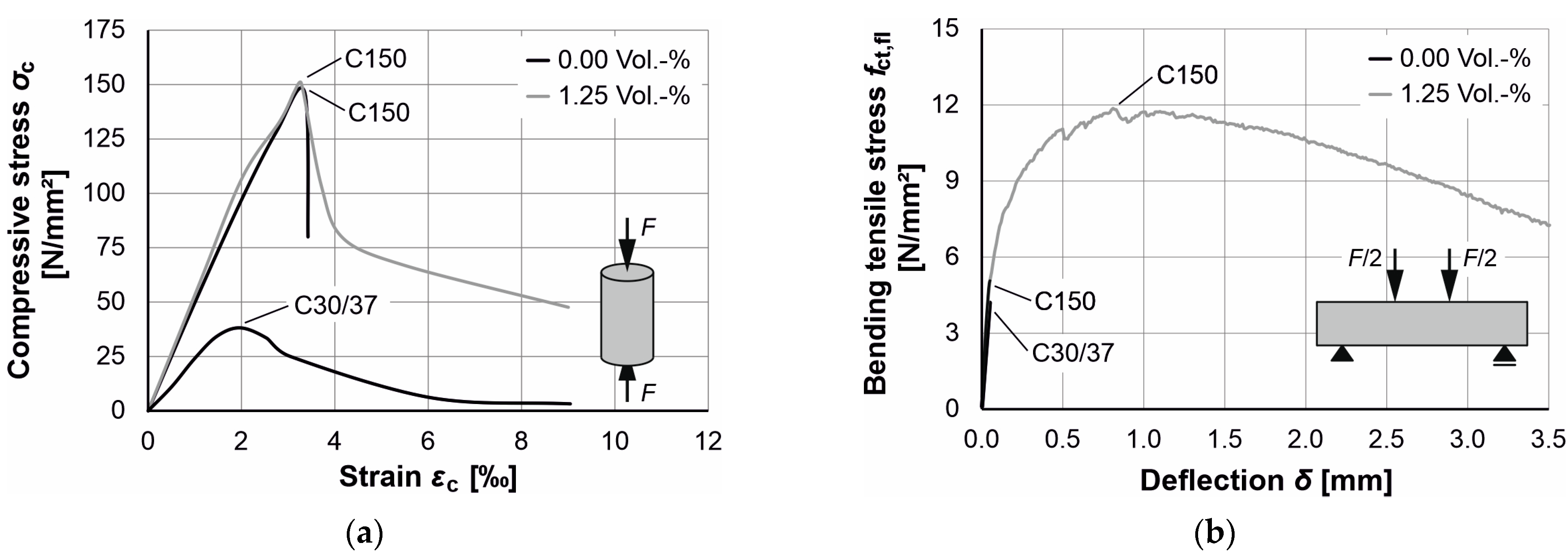

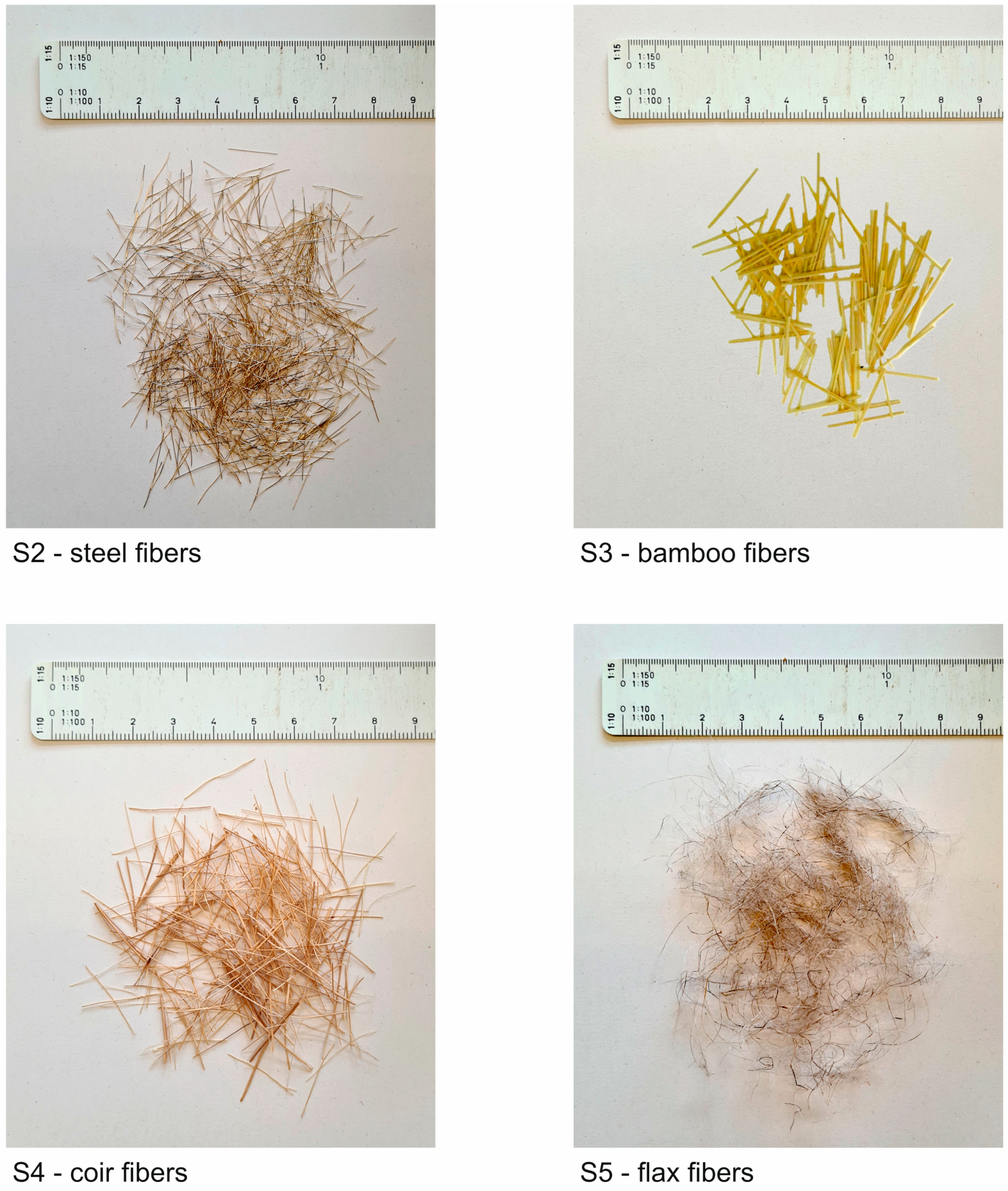
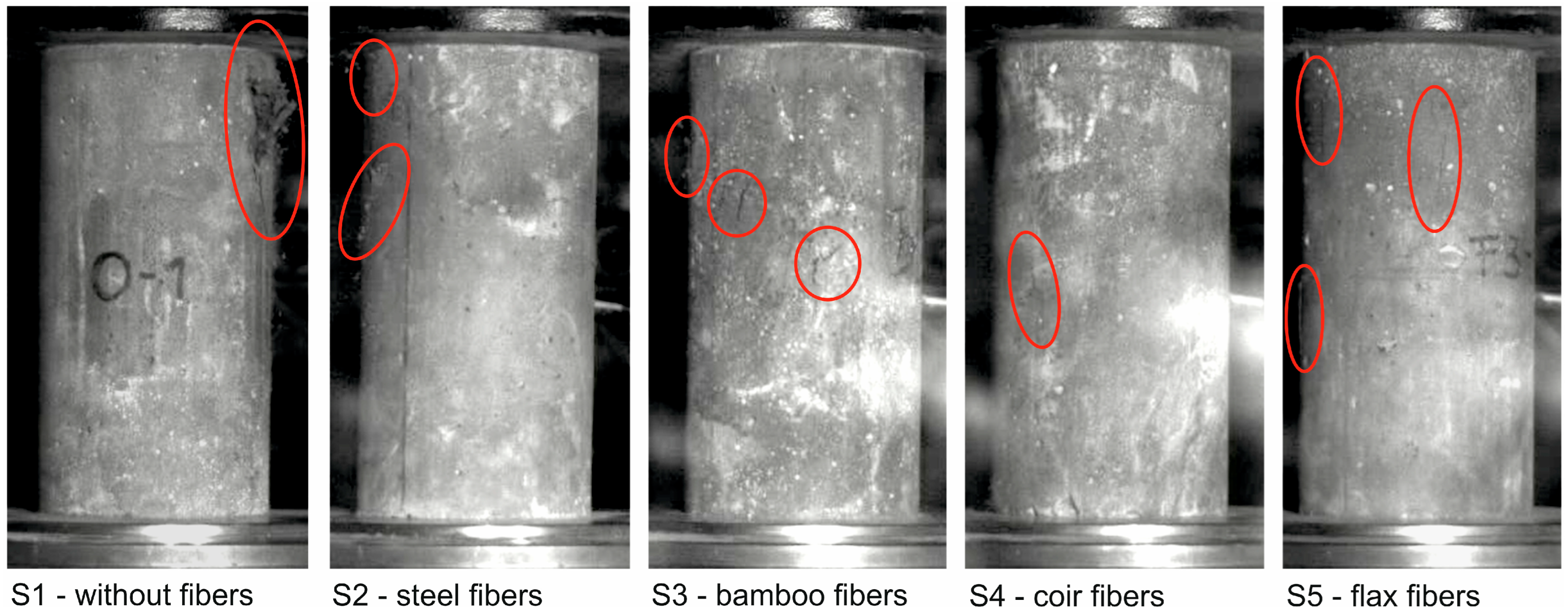

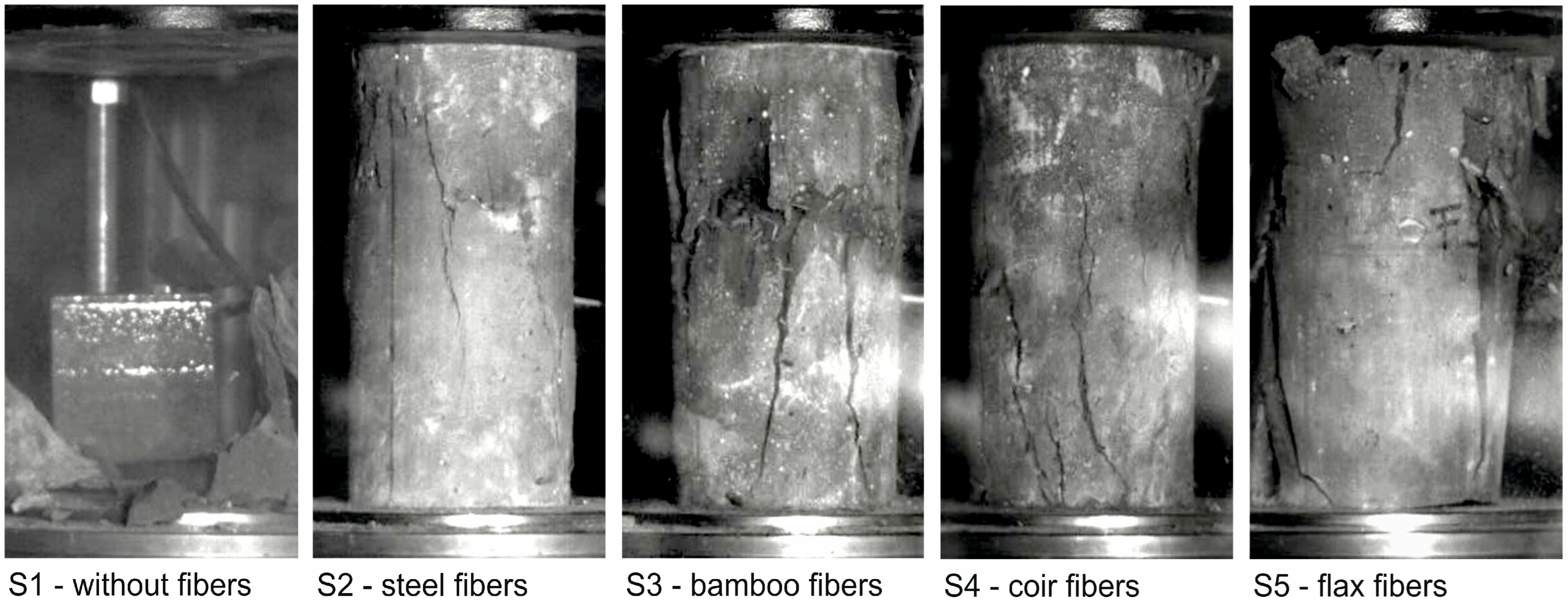
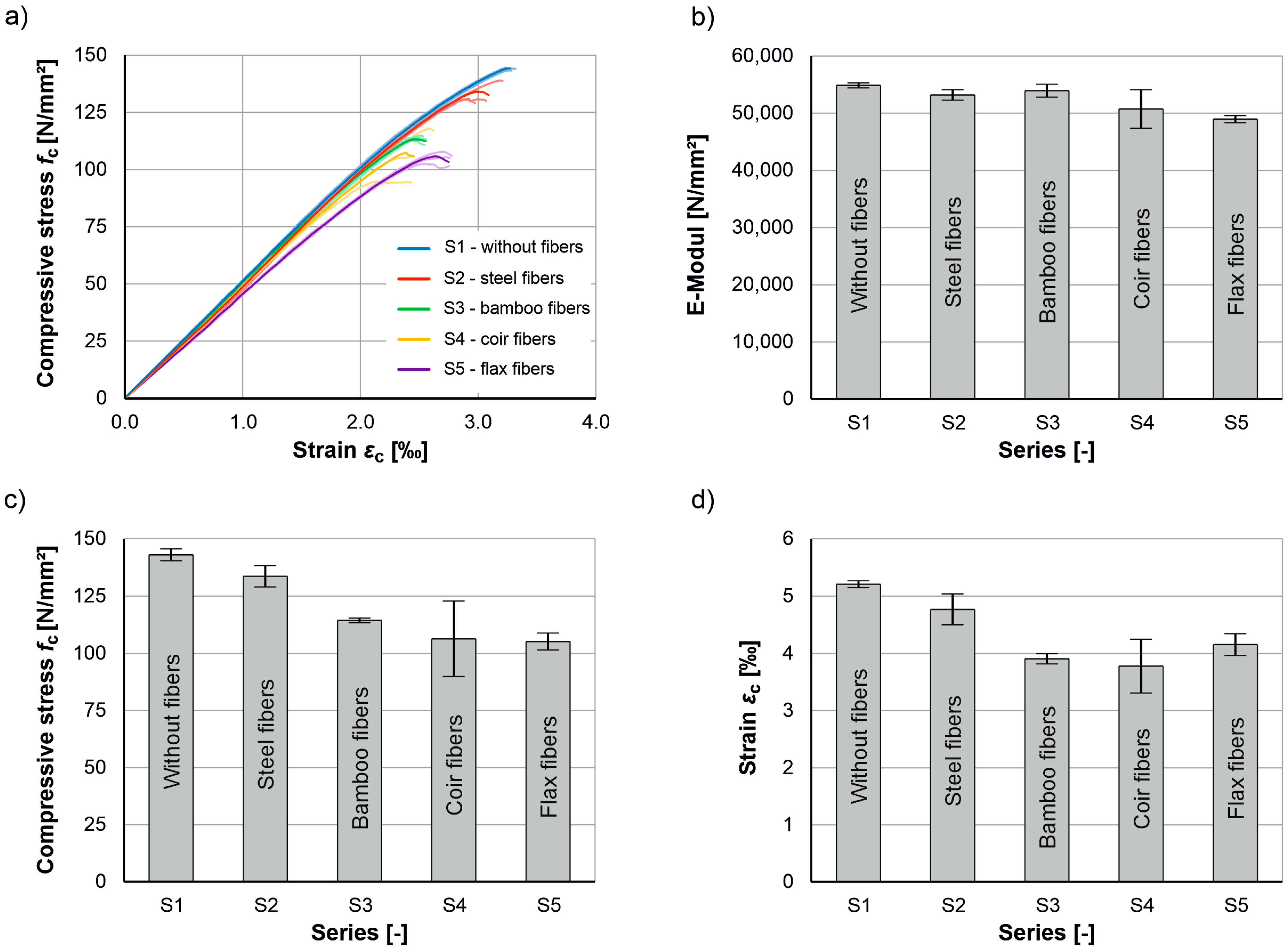
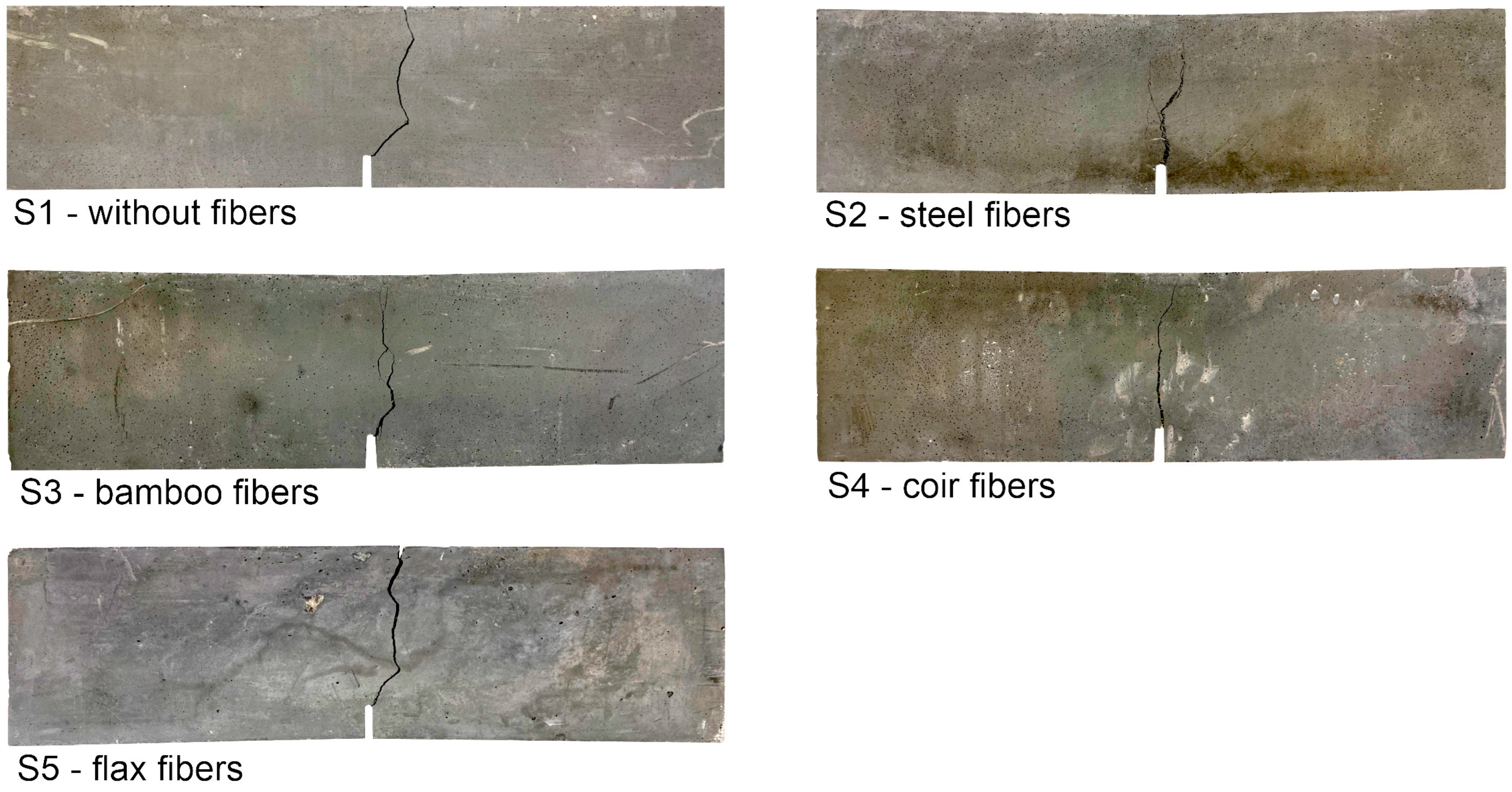
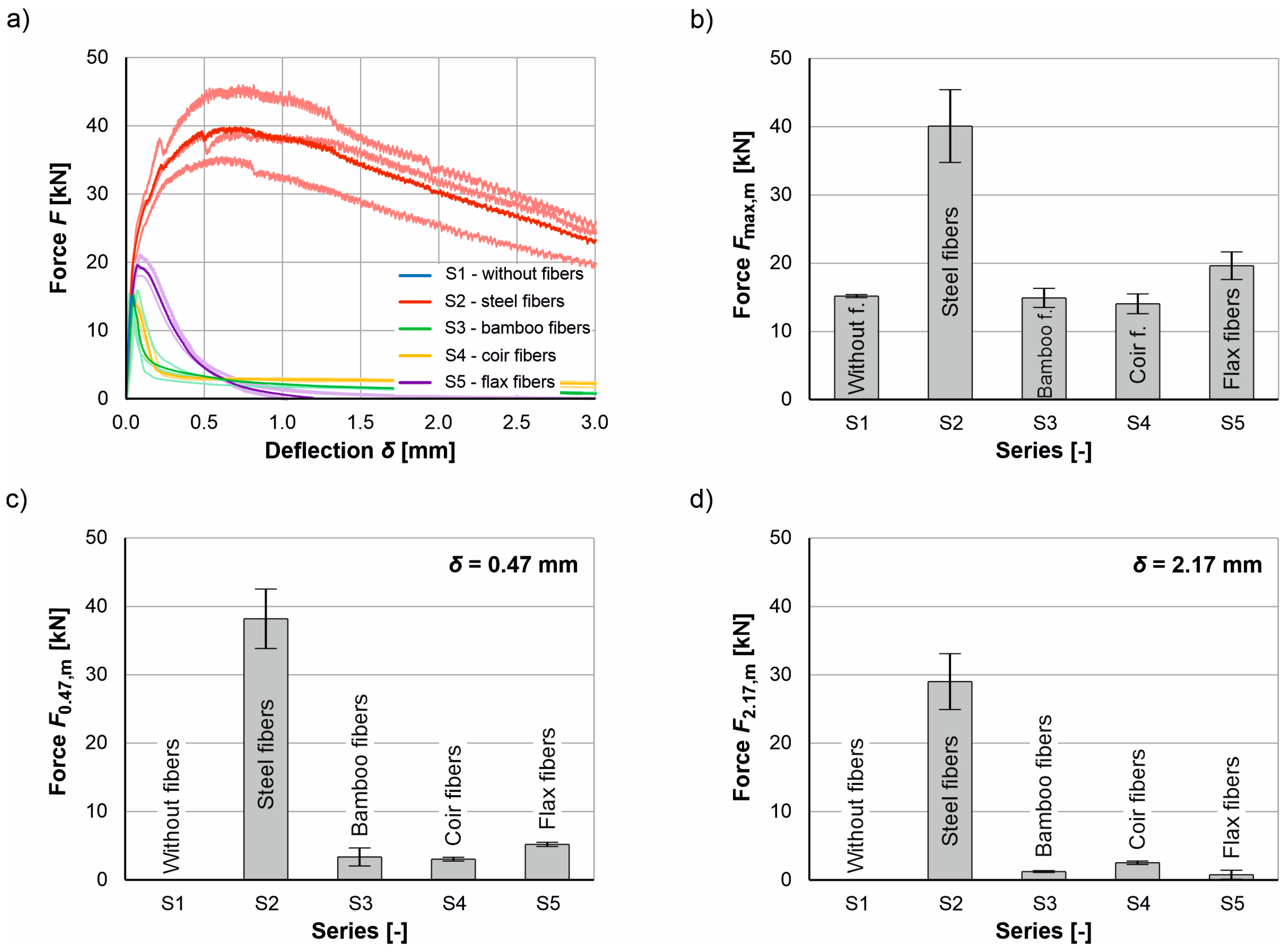
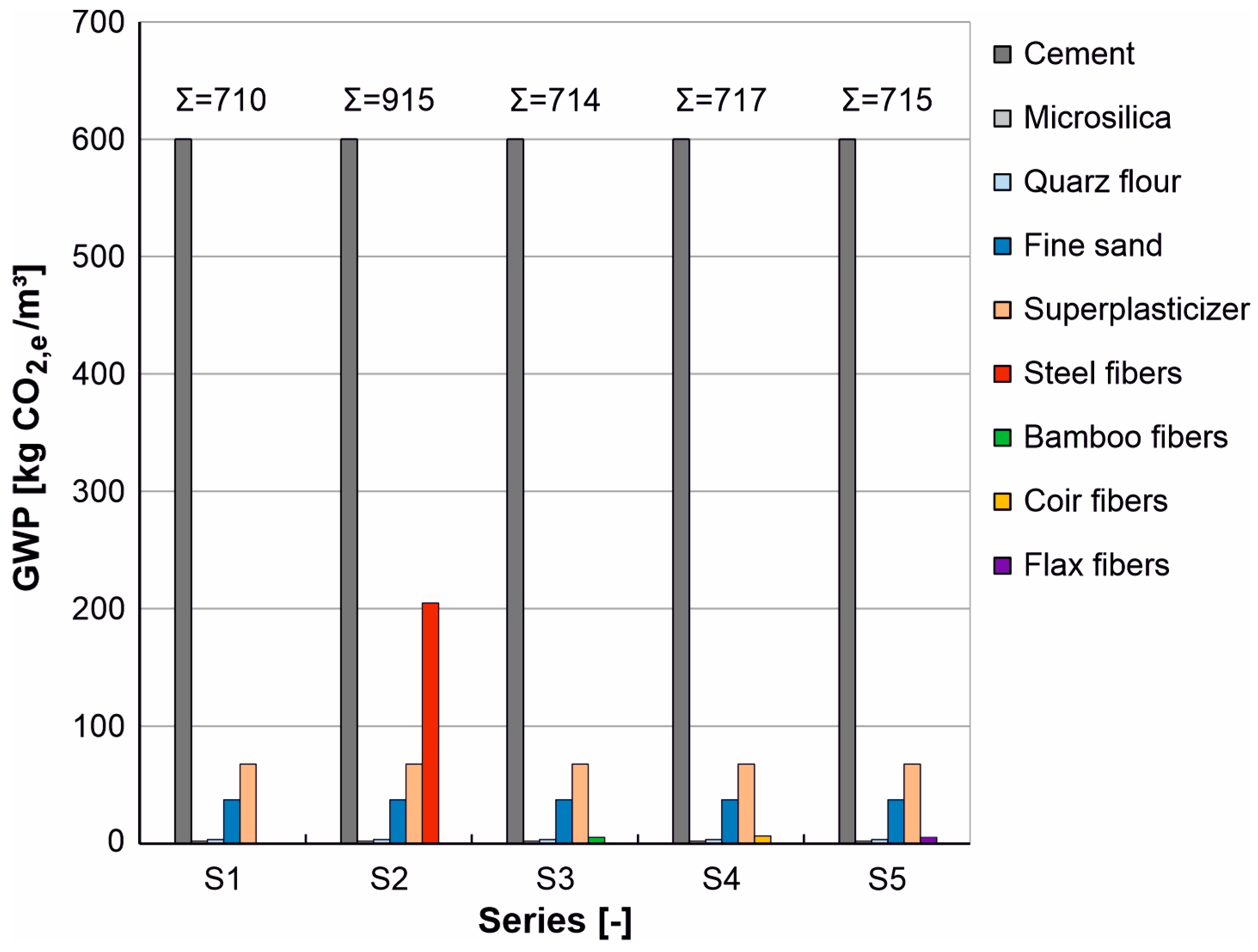
| Fiber | Cellulose [%] | MFA [°] | Tensile Strength [N/mm2] | Module of Elasticity [N/mm2] |
|---|---|---|---|---|
| Bamboo | 60 | 8 | 400 | 35,000 |
| Coir | 35 | 45 | 150 | 5000 |
| Flax | 70 | 7 | 1000 | 60,000 |
| Sisal | 65 | 17 | 450 | 40,000 |
| Hemp | 65 | 4 | 700 | 50,000 |
| Series | Fiber Type [-] | Fiber Content [Vol.-%] | Number of Cylinders [-] | Cylinder Geometry [cm] | Number of Beams [-] | Beam Geometry [cm] |
|---|---|---|---|---|---|---|
| S1 | - | 0 | 3 | d/h = 10/20 | 3 | l/b/h = 55/15/15 |
| S2 | Steel fibers | 1.25 | 3 | d/h = 10/20 | 3 | l/b/h = 55/15/15 |
| S3 | Bamboo fibers | 1.25 | 3 | d/h = 10/20 | 3 | l/b/h = 55/15/15 |
| S4 | Coir fibers | 1.25 | 3 | d/h = 10/20 | 3 | l/b/h = 55/15/15 |
| S5 | Flax fibers | 1.25 | 3 | d/h = 10/20 | 3 | l/b/h = 55/15/15 |
| Components of the Concrete | S1 | S2 | S3 | S4 | S5 |
|---|---|---|---|---|---|
| CEM I 52.5 R-SR3/NA (Holcim Sulfo 5R, Sehnde, Germany) | 795 | 795 | 795 | 795 | 795 |
| Silica fume (Sika® Silicoll P (uncompacted), Stuttgart, Germany) | 169 | 169 | 169 | 169 | 169 |
| Quartz flour (Quarzwerke MILLSIL® W12, Frechen, Germany) | 198 | 198 | 198 | 198 | 198 |
| Fine sand (0/0.5 mm) (Quarzwerke H33) | 971 | 971 | 971 | 971 | 971 |
| Superplasticiser (BASF MasterGlenium® ACE 394, Staßfurt, Germany) | 36 | 36 | 36 | 36 | 36 |
| Steel fibers (Stratec Weidacon FM 0.19 × 13 mm, Hemer, Germany) | - | 98 | - | - | - |
| Bamboo fibers | - | - | 10 | - | - |
| Coir fibers | - | - | - | 15 | - |
| Flax fibers | - | - | - | - | 18 |
| Adding water | 188 | 188 | 188 | 188 | 188 |
| Fiber | Length [mm] | Diameter [mm] | Raw Density [kg/m3] |
|---|---|---|---|
| Steel | 13 | 0.19 | 7850 |
| Bamboo | 20 | 0.5–1.0 | 800 |
| Coir | 15–20 | 0.2–0.8 | 1200 |
| Flax | 15–20 | ≤0.2 | 1450 |
| Fiber | Pectin [wt%] | Hemicellulose [wt%] | Lignin [wt%] | Cellulose [wt%] |
|---|---|---|---|---|
| Bamboo | 0.5–1.5 | 20–25 | 10–30 | 45–65 |
| Coir | 1–3 | <1 | 40–45 | 30–40 |
| Flax | 1–4 | 11–18 | 2–3 | 60–75 |
| Series | Fiber Type [-] | [N/mm2] | [N/mm2] | [‰] | [‰] | E-Modul [N/mm2] | [N/mm2] |
|---|---|---|---|---|---|---|---|
| S1 | - | 143.0 | 2.6 | 3.25 | 0.06 | 54,867 | 439 |
| S2 | Steel fibers | 133.6 | 4.7 | 2.98 | 0.27 | 53,185 | 926 |
| S3 | Bamboo fibers | 114.4 | 1.0 | 2.44 | 0.09 | 53,948 | 1126 |
| S4 | Coir fibers | 106.4 | 16.5 | 2.36 | 0.47 | 50,742 | 3364 |
| S5 | Flax fibers | 105.2 | 3.7 | 2.60 | 0.19 | 48,981 | 622 |
| Series | Fiber Type [-] | [kN] | [kN] | [kN] | [kN] | [kN] | [kN] |
|---|---|---|---|---|---|---|---|
| S1 | - | 15.16 | 0.18 | 0.00 | 0.00 | 0.00 | 0.00 |
| S2 | Steel fibers | 40.22 | 5.33 | 38.20 | 4.36 | 29.00 | 4.10 |
| S3 | Bamboo fibers | 14.90 | 1.40 | 3.35 | 1.31 | 1.23 | 0.14 |
| S4 | Coir fibers | 14.02 | 1.45 | 3.03 | 0.27 | 2.52 | 0.25 |
| S5 | Flax fibers | 19.61 | 2.02 | 5.19 | 0.30 | 0.77 | 0.84 |
| Components of the Concrete | GWP [kg CO2,e/kg] A1–A3 | Data Source |
|---|---|---|
| Cement CEM I 52.5R | 0.755 | [126] |
| Microsilica | 0.0061 | [127] |
| Quartz flour | 0.0181 | [128] |
| Fine sand | 0.0385 | [127] |
| Superplasticizer | 1.88 | [129] |
| Steel fibers | 2.09 | [127] |
| Bamboo fibers | 0.38 | [130] |
| Coir fibers | 0.45 | [131] |
| Flax fibers | 0.31 | [127] |
Disclaimer/Publisher’s Note: The statements, opinions and data contained in all publications are solely those of the individual author(s) and contributor(s) and not of MDPI and/or the editor(s). MDPI and/or the editor(s) disclaim responsibility for any injury to people or property resulting from any ideas, methods, instructions or products referred to in the content. |
© 2024 by the authors. Licensee MDPI, Basel, Switzerland. This article is an open access article distributed under the terms and conditions of the Creative Commons Attribution (CC BY) license (https://creativecommons.org/licenses/by/4.0/).
Share and Cite
Joachim, L.; Oettel, V. Experimental Investigations on the Application of Natural Plant Fibers in Ultra-High-Performance Concrete. Materials 2024, 17, 3519. https://doi.org/10.3390/ma17143519
Joachim L, Oettel V. Experimental Investigations on the Application of Natural Plant Fibers in Ultra-High-Performance Concrete. Materials. 2024; 17(14):3519. https://doi.org/10.3390/ma17143519
Chicago/Turabian StyleJoachim, Linus, and Vincent Oettel. 2024. "Experimental Investigations on the Application of Natural Plant Fibers in Ultra-High-Performance Concrete" Materials 17, no. 14: 3519. https://doi.org/10.3390/ma17143519
APA StyleJoachim, L., & Oettel, V. (2024). Experimental Investigations on the Application of Natural Plant Fibers in Ultra-High-Performance Concrete. Materials, 17(14), 3519. https://doi.org/10.3390/ma17143519







